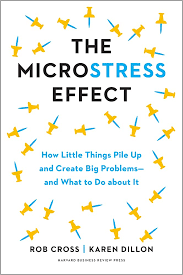Do you Feel Pulled in a Million Directions? This Researcher Shows Us How to Manage the Hidden Toll of Microstress
Several years ago, Karen Dillon and Rob Cross were interviewing high-career performers to understand how these people succeeded so well at work. But the two authors—Dillon, the former editor of the Harvard Business Review, and Cross, a research scientist, and professor—discovered an unexpected-yet-ubiquitous theme: Those they interviewed felt overwhelmed, unbalanced, and pulled in a million directions.
That discovery led Dillon and Cross to investigate further: After interviewing 300 people, they found everyone, in some way, was struggling to get through—not because of giant stresses but hundreds of little ones. Dillon and Cross coin these “microstresses”: minor setbacks that accumulate to have a ripple effect.
“In the beginning, we didn’t have language for it,” Dillon tells The Sunday Paper. “It sounded silly to talk about how an email derailed a day. Just one little email, who can’t recover from that? But we realized in the research that people have not one but dozens of [microstresses] on any given day, and that was affecting their performance, overall wellbeing, and making them feel so out of control of their lives.”
Because so many of us can relate to this feeling, we dug into the topic with Dillon. She talks with us about her and Cross’s new book, The Microstress Effect: How Little Things Pile Up and Create Big Problems—and What to Do About It, and how we can start getting ahead of this all-to-common issue.
A CONVERSATION WITH KAREN DILLON
How do you define "microstresses"?
They're tiny stresses that occur in interaction with specific things—interaction with people we're close to personally or professionally—that are so routine and baked into our days that we barely remember them but whose cumulative effect is enormous.
Again, these happen as we go about our day, always in interaction with another, which creates a ripple effect of stress that will stick with you.
It's the accumulation of these that takes the toll. Why?
We found that none of us have just one or two microsstresses during the day, because one or two we could overcome. We have dozens, and they layer up and take a toll on us—sometimes in a way that we're unaware of.
You and Cross write that there are different types of microstresses. To name three, there are capacity-draining, emotion-depleting, and identity-challenging. Please walk us through these.
Capacity-draining microstresses are the ones that are the sticky notes out all over your laptop or the things taking up space on your calendar. They're all the things that happen to you that interfere with your ability to get things done—and again, they're small interactions.
A common example is when a colleague slightly lets us down. Maybe they didn't finish the project, for instance. Somehow, somebody's exhausted getting to the finish line and comes up short. The microstress of that is not only the consequences of the unfinished project, but also if you now must put in the extra 5 percent to make up for it.
Emotion-depleting microstresses are those that, little by little, eat away at your well of emotions, resilience, and energy you start the day with. A common one in work and life is what we call 'secondhand stress.' We may not be stressed in the moment, but maybe we have a colleague or loved one who sprays stress all over the place. They're worried, and they make you feel agitated about something. We actually feel that. Some interesting research shows that if you're in the room with someone you care about experiencing pain, there are mirror neurons in your brain that will actually experience it as if you're having the pain yourself. So secondhand stress is a powerful microstress at work and at home.
And the third is microstresses that challenge your identity. These are things that just make you feel bad about yourself. You may think I'm not the mom I want to be or feel uncomfortable being a high-pressure salesperson. That's not who I am. These can also be draining or negative interactions with family and friends. An example is when we're scrambling to get out the door in the morning and snap at our partner or kids. That sticks with you all day. You feel bad about yourself, and it drains that well of yours.
How do we start to recognize microstresses and push back?
A key point we make in the book is that small changes can make a big difference. You can pick two or three microstresses in your life that are systemic enough and are worth pushing back on. To do this, we point to the interaction: If you can remove a negative interaction—social science research states that a negative experience or interaction can have up to five times a greater effect than a positive one—that can make a big difference. Take the colleague example. If you can spend five minutes doing that basic level of communication— Who's doing what, when? Did you see my tracked changes? Do I send this to you?—that can be so helpful.
Another thing is we all have people in our lives who text whatever negative thing is on their minds. They may have forgotten it right after sending it, but you think about it all day. To change this, you could say, 'I'm happy to be here for you whenever you need me, but maybe we have a call instead of you sending the gratuitous stress-relief texts.' You can change the interaction without changing the relationship.
Also, it's important to know we're a culture of 'yes.' We want to be yes people. To push back on this, just pausing and giving yourself permission to ask good questions—Is it as important? When do you need this? Perhaps someone else is more suited for this?—can be helpful. Any kind of communication about something you need to do at work or home, even by pausing and asking yourself, is a good start.
How does connecting with people help us deal with microstress?
Of the 300 high performers we interviewed, there was a small subset—we started calling them the '10 percenters'—who actually seem to manage microstress better than the rest of us. They were better at pushing back and asking good questions or drawing boundaries. What they did was they always made time to be connected with people, even in small moments. One person had an informal lunch with a junior person once a month. Another one of the '10 percenters' with a vibrant, rich life told us they got good at 'respectful no's', so they had time and space for ‘enthusiastic spontaneous yeses.’ Doing this helps put all those microstresses in perspective.

Karen Dillon is the co-author of the three books, her most recent being The Microstress Effect: How Little Things Pile Up and Create Big Problems—and What to Do about It. A former editor of Harvard Business Review, Dillon is also a current member of the faculty of Intermountain Healthcare Leadership Institute.
Please note that we may receive affiliate commissions from the sales of linked products.



